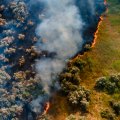Prevention program achieves 40 percent reduction in falls among older people
A prevention program developed by University of Queensland researchers has reduced falls in a test group of older people by up to 40 percent.
Chief investigators in the research to develop the program were Dr Margaret Steinberg and Colleen Cartwright of the University's Healthy Ageing Research Unit, and senior research officer Nancye Peel.
The research was funded by a two-year, $200,000 Queensland Health Promotion Council grant.
Falls were the greatest cause of accidental death and injury in people aged over 65, said Dr Steinberg, the Unit director. Even non-injurious falls often led to a loss of independence in older people - 40 percent of older people quoted falls, with and without injury, as the main reason for entering nursing homes, she said.
In Queensland in 1994-95, 8957 people aged 65 and over were hospitalised due to falls while for the same period and age group, 157 died as a result of their fall.
Falls were one of the Federal Government's main health priorities for older people and finding effective prevention strategies had become a more pressing aim since 1999 was the Year of Older Persons, Dr Steinberg said.
To develop the program, the researchers tested three prevention strategies on three groups of people (189 in total) aged between 54 and 87. These were recruited through the National Seniors Association. One group was exposed to one strategy, a second group to two strategies and a third group to all three. A fourth group of 63 people acted as control.
The prevention strategies included: exercise classes emphasising strength and balance; a home assessment and modification program (including removal or relocation of items such as loose floor mats and installation of grab rails in bathrooms and near steps); and a medical assessment (including a check that combinations of drugs were not causing a higher vulnerability to falls).
The researchers found that while all three groups achieved significant reductions in slips, trips and falls over a 17-month period, the group exposed to all three programs achieved the highest reduction.
Dr Steinberg said all three groups achieved between a 52-65 percent reduction in the risk of slipping, a 55-71 percent reduction in the risk of tripping and an 18-40 percent reduction in the risk of falling over the period. The highest result in each category was achieved by the group exposed to all three strategies, she said.
"We also found that the process of filling out the calendar and chart about slips, trips and falls for the data collection aspect of this study even became a prevention strategy in itself. People told us it had made them more aware of potential fall zones in their homes," she said.
Program elements were already available in the community but needed to be better co-ordinated, enhanced and made uniformly available, Dr Steinberg said.
"Community organisations could be funded to run the program through local health centres. The State Government already provides programs such as Home Assist Home Secure for home safety assessment and modification for older people," she said.
It could also be grafted on to general health and lifestyle programs such as Queensland Health's "60 and Better", she said.
For more information, contact Dr Steinberg (telephone 07 3365 5424), Ms Cartwright (telephone 07 3365 5328) or Ms Peel (telephone 07 3365 5383).
.jpg)

